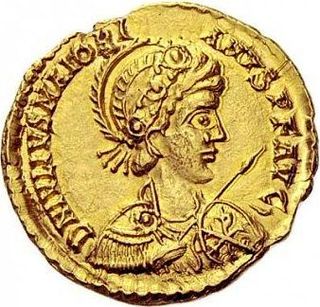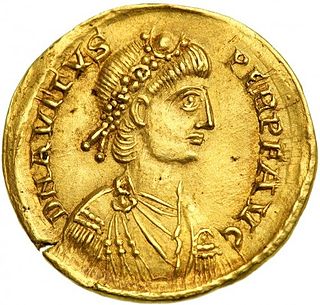The 400s decade ran from January 1, 400, to December 31, 409.
The 470s decade ran from January 1, 470, to December 31, 479.
The 430s decade ran from January 1, 430, to December 31, 439.
The 450s decade ran from January 1, 450, to December 31, 459.

Year 451 (CDLI) was a common year starting on Monday of the Julian calendar. At the time, it was known as the Year of the Consulship of Marcianus and Adelfius. The denomination 451 for this year has been used since the early medieval period, when the Anno Domini calendar era became the prevalent method in Europe for naming years.
The 440s decade ran from January 1, 440, to December 31, 449.
The 460s decade ran from January 1, 460, to December 31, 469.
Year 454 (CDLIV) was a common year starting on Friday of the Julian calendar. At the time, it was known as the Year of the Consulship of Aetius and Studius. The denomination 454 for this year has been used since the early medieval period, when the Anno Domini calendar era became the prevalent method in Europe for naming years.

Year 455 (CDLV) was a common year starting on Saturday of the Julian calendar. At the time, it was known as the Year of the Consulship of Valentinianus and Anthemius. The denomination 455 for this year has been used since the early medieval period, when the Anno Domini calendar era became the prevalent method in Europe for naming years.

Year 466 (CDLXVI) was a common year starting on Saturday of the Julian calendar. At the time, it was known as the Year of the Consulship of Leo and Tatianus. The denomination 466 for this year has been used since the early medieval period, when the Anno Domini calendar era became the prevalent method in Europe for naming years.

Year 448 (CDXLVIII) was a leap year starting on Thursday of the Julian calendar. At the time, it was known as the Year of the Consulship of Praetextatus and Zeno. The denomination 448 for this year has been used since the early medieval period, when the Anno Domini calendar era became the prevalent method in Europe for naming years.

Ricimer was a Romanized Germanic general, who ruled the remaining territory of the Western Roman Empire from 456 after defeating Avitus, until his death in 472, with a brief interlude in which he contested power with Procopius Anthemius. Deriving his power from his position as magister militum of the Western Empire, Ricimer exercised political control through a series of puppet emperors. Ricimer's death led to unrest across Italy and the establishment of a Germanic kingdom on the Italian Peninsula.

Majorian was Western Roman emperor from 457 to 461. A prominent commander in the Western military, Majorian deposed Avitus in 457 with the aid of his ally Ricimer at the Battle of Placentia. Possessing little more than Italy and Dalmatia, as well as some territory in Hispania and northern Gaul, Majorian campaigned rigorously for three years against the Empire's enemies. In 461, he was murdered at Dertona in a conspiracy, and his successors until the fall of the Empire in 476 were puppets either of barbarian generals or the Eastern Roman court.

Procopius Anthemius was the Western Roman emperor from 467 to 472. Born in the Eastern Roman Empire, Anthemius quickly worked his way up the ranks. He married into the Theodosian dynasty through Marcia Euphemia, daughter of Eastern emperor Marcian. He soon received a significant number of promotions to various posts, and was presumed to be Marcian's planned successor. However, Marcian's sudden death in 457, together with that of Western emperor Avitus, left the imperial succession in the hands of Aspar, who instead appointed Leo, a low-ranking officer, to the Eastern throne, probably out of fear that Anthemius would be too independent. Eventually, this same Leo designated Anthemius as Western emperor in 467, following a two-year interregnum that started in November 465.

Eparchius Avitus was Roman emperor of the Western Empire from July 455 to October 456. He was a senator of Gallic extraction and a high-ranking officer both in the civil and military administration, as well as Bishop of Piacenza.

The Kingdom of the Suebi, also called the Kingdom of Galicia or Suebi Kingdom of Galicia, was a Germanic post-Roman kingdom that was one of the first to separate from the Roman Empire. Based in the former Roman provinces of Gallaecia and northern Lusitania, the de facto kingdom was established by the Suebi about 409, and during the 6th century it became a formally declared kingdom identifying with Gallaecia. It maintained its independence until 585, when it was annexed by the Visigoths, and was turned into the sixth province of the Visigothic Kingdom in Hispania.
Remistus was a general of the Western Roman Empire and commander-in-chief of the army under Emperor Avitus.
The Battle of Agrigentum was fought in 456 A.D. at Agrigentum, now Agrigento in modern-day Sicily. An army of the Western Roman Empire, led by the general Ricimer, drove off an invading force, a fleet of sixty ships, sent by the Vandal king Gaiseric to raid Sicily. Ricimer then led the Roman fleet against the Vandals and defeated them in a naval battle off the coast of Corsica. The victory gave the Romans only temporary relief from Vandal raids.

The Gothic War of 457–458 was a military conflict between the Visigoths of Theoderic II against the Western Roman Empire of Emperor Majorian. The war began in 457 with a revolt of the Goths in Aquitania that pushed aside Roman authority, followed by an aggressive conquest in the adjacent Septimania aimed at area expansion. The war ended with a Roman victory over the Goths in the Battle of Arles in 458.

The Roman Civil War of 456 was a civil war fought in the Western Roman Empire during the second half of 456 AD.











